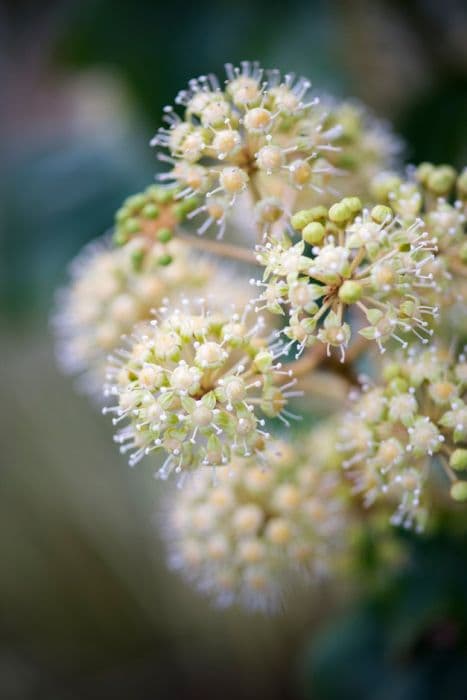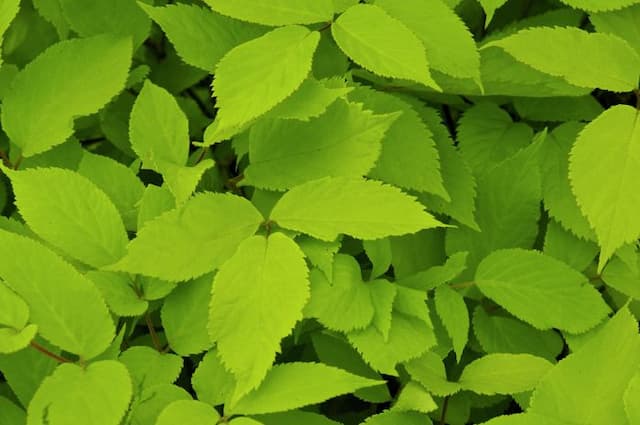English Ivy Hedera helix 'Eva' (v)

ABOUT
Hedera helix 'Eva', commonly known as English ivy, features a lush and dense foliage that exhibits a distinctive appearance. The plant is characterized by its bold and variegated leaves, which usually have a heart-shaped or three to five-lobed form. The leaves of the 'Eva' variety are edged with creamy-white to yellow margins, while the centers exhibit a rich, dark green color, creating a striking contrast. The variegation can add a lovely ornamental quality to the plant. The leaves possess a waxy sheen and a slightly leathery texture, contributing to their robust appearance. As a climbing or ground-covering plant, English ivy will typically produce aerial rootlets along its stems that help it attach to surfaces or spread across the ground, presenting a vigorous and vibrant display of intertwined greenery. The overall impression of Hedera helix 'Eva' is of a lush, evergreen plant that adds a touch of elegance and visual interest to its surroundings, whether growing upwards or trailing along.
About this plant
 Names
NamesFamily
Araliaceae.
Synonyms
English Ivy, Common Ivy, European Ivy.
Common names
Hedera helix 'Eva'.
 Toxicity
ToxicityTo humans
English Ivy, which is the most common name for Hedera helix 'Eva', contains several compounds that can be toxic to humans if ingested. These compounds include saponins, hederin, and polyacetylene compounds. If any part of the plant is eaten, it can lead to gastrointestinal distress, including symptoms like nausea, vomiting, diarrhea, and abdominal pain. In severe cases, ingestion might also result in increased salivation, difficulty in breathing, and even fever. Contact with the skin might lead to dermatitis in some individuals. It is important to seek medical attention if any part of the plant is ingested or if a skin reaction develops.
To pets
English Ivy, or simply Ivy, is toxic to pets including cats and dogs. The toxic components are saponins, which can cause vomiting, abdominal pain, hypersalivation, and diarrhea if ingested. In severe cases, particularly with large amounts ingested, the ingestion of Ivy can also lead to more serious symptoms such as trembling, convulsions, and potentially even coma. Pets who have ingested Ivy should receive prompt veterinary care. It is important to keep this plant out of reach of pets.
 Characteristics
CharacteristicsLife cycle
Perennials
Foliage type
Evergreen
Color of leaves
Variegated
Height
6 8 (20cm)
Spread
3 0 (91cm)
Plant type
Climber
Hardiness zones
5
Native area
Europe
Benefits
 General Benefits
General Benefits- Easy to grow: English Ivy 'Eva' is hardy and adaptable, which makes it suitable for a variety of growing conditions.
- Ornamental appeal: Its attractive foliage adds aesthetic value to indoor and outdoor spaces.
- Growth habit: It can serve as a ground cover, reducing soil erosion and suppressing weeds.
- Versatile: It can grow in containers, hang in baskets, or be trained on trellises.
- Low maintenance: It requires minimal care once established and is not demanding about soil quality or moisture levels.
- Seasonal interest: English Ivy 'Eva' provides year-round greenery adding to the landscape's visual interest even in winter.
- Privacy: When used as a screen, English Ivy 'Eva' can provide a sense of seclusion and privacy.
- Wildlife habitat: It offers shelter and food for birds and insects, contributing to local biodiversity.
- Tolerance: It exhibits tolerance to a wide range of temperatures, making it suitable for many different climates.
 Medical Properties
Medical Properties- Expectorant: English ivy is traditionally used to help relieve coughs and bronchitis.
- Anti-inflammatory: The plant contains saponins, which are thought to have anti-inflammatory properties.
- Antimicrobial: Some studies suggest that English ivy may possess antimicrobial effects against certain bacteria and fungi.
- Antispasmodic: It is thought to possess antispasmodic properties, potentially providing relief from muscle spasms.
- Mucolytic: English ivy may help in thinning mucus, aiding in the clearance of respiratory secretions.
 Air-purifying Qualities
Air-purifying QualitiesThis plant is not specifically known for air purifying qualities.
 Other Uses
Other Uses- Hedera helix 'Eva', commonly known as English ivy, can be used as a natural dye, producing a range of colors from green to brown depending on the mordant used.
- English ivy leaves can be boiled to create a waterproofing solution for natural fabrics or materials as the saponins it contains can add a protective layer.
- The vines of English ivy may be woven into baskets or other handicrafts, an unconventional form of upcycling plant material.
- When dried and crushed, the leaves of English ivy can serve as a natural insect repellent to ward off pests like moths from closets or drawers.
- The plant can be trained to grow in specific shapes or letters for topiary garden art, adding a personal touch to garden design.
- English ivy stems can be used as natural binding materials in garden construction or support for other plants due to their flexibility and strength.
- Used artistically, the leaves of English ivy can be incorporated into eco-printing techniques on paper or fabric to create unique patterns and designs.
- The climbing nature of English ivy can create living curtains when grown on trellises next to windows, offering privacy and shade.
- When grown as a ground cover, English ivy can help prevent soil erosion on slopes or in areas where grass has difficulty growing.
- Incorporating English ivy into a terrarium can create a lush miniature landscape due to its ability to thrive in the high humidity environment.
Interesting Facts
 Feng Shui
Feng ShuiEnglish Ivy is used in Feng Shui to introduce wood energy, symbolizing growth and renewal. It can be placed in the East sector of a space for health and family, or Southeast for wealth and abundance. Its climbing nature allows for upward growth, which can be seen as promoting positive chi.
 Zodiac Sign Compitability
Zodiac Sign CompitabilityEnglish Ivy is not used in astrology practice.
 Plant Symbolism
Plant Symbolism- Friendship: The plant, commonly known as English ivy, often symbolizes friendship due to its nature to cling and grow closely alongside structures and other plants, representing the intertwining and supportive aspect of friendships.
- Eternal life: English ivy is an evergreen plant, remaining green throughout the year, making it a symbol of eternal life and immortality.
- Fidelity: This plant is known for its strong and lasting attachment to surfaces, which represents steadfastness and loyalty in relationships, leading to its association with fidelity.
- Protection: In folklore, it is believed that English ivy has protective qualities, such as warding off evil spirits, which is why it is often planted around homes.
- Survival and Determination: English ivy has the ability to survive in challenging conditions and to overcome obstacles as it climbs, symbolizing the human qualities of survival and determination.
 Water
WaterEnglish Ivy 'Eva' should be watered when the top inch of the soil feels dry to the touch, which is typically once every week or two, depending on the humidity and temperature of the environment. It's important not to overwater, so ensure that the pot has drainage holes and the excess water can escape. When watering, it's best to do so thoroughly until water runs out of the bottom of the pot. Generally, using about half a gallon of water per watering session for a standard-sized indoor pot is sufficient, but you should adjust the amount based on the size of your pot and the plant's environment.
 Light
LightEnglish Ivy 'Eva' thrives in bright, indirect light and can also adapt to low-light conditions. The ideal spot for this plant is near a north-facing window or a few feet away from a south or west-facing window where the light is filtered. Avoid direct sunlight, as it can scorch the leaves.
 Temperature
TemperatureEnglish Ivy 'Eva' prefers a temperature range between 50 to 70 degrees Fahrenheit, but can survive in temperatures as low as 10 degrees and as high as 90 degrees Fahrenheit. The ideal temperature conditions would be within the moderate range, avoiding the extremes to ensure healthy growth and foliage.
 Pruning
PruningPruning English Ivy 'Eva' encourages bushier growth and can help prevent pests and diseases by improving air circulation. It's best to prune in the spring or early summer, removing any dead or damaged leaves and trimming back as needed to maintain the desired shape. Pruning can be done every few months or annually, depending on the plant's appearance and health.
 Cleaning
CleaningAs needed
 Soil
SoilEnglish Ivy 'Eva' thrives best in a well-draining soil mix, comprising one part peat, one part pine bark, and one part perlite or coarse sand. The ideal soil pH for English Ivy is slightly acidic to neutral, ranging from 6.0 to 7.5.
 Repotting
RepottingEnglish Ivy 'Eva' should generally be repotted every two to three years to ensure it has enough room to grow and to refresh the soil. It's best to repot in the spring just before the growing season begins.
 Humidity & Misting
Humidity & MistingEnglish Ivy 'Eva' prefers high humidity levels, ideally between 40% to 70%. Regular misting can help achieve this, especially in dry indoor environments.
 Suitable locations
Suitable locationsIndoor
Place English Ivy 'Eva' in bright, indirect light and maintain humidity.
Outdoor
Grow English Ivy 'Eva' in partial shade, moist soil, sheltered from extreme heat.
Hardiness zone
5-11 USDA
 Life cycle
Life cycleThe English Ivy 'Eva' begins its life cycle when seeds are dispersed by birds after they consume the fruit. Upon successful germination, the seedling develops into a juvenile phase characterized by lobed, waxy leaves and a preference for shady conditions, where it often acts as a ground cover. As it matures, it starts to climb, using aerial rootlets to adhere to surfaces, entering its adult stage characterized by unlobed leaves and the potential to flower when exposed to full sun. During the adult phase, it produces small, greenish-yellow flowers in late summer, which are not particularly showy but are beneficial to pollinators. Following pollination, these flowers develop into berry-like fruits that ripen to a dark blue-black, completing the reproductive cycle. The plant may continue this annual flowering and fruiting cycle for many years, while the vegetative parts can live and remain active, contributing to the plant's growth and proliferation.
 Propogation
PropogationPropogation time
Spring-Early Summer
The Hedera helix 'Eva', commonly known as the English ivy 'Eva' variety, is best propagated during spring through early summer to allow sufficient time for rooting before the cooler months set in. The most popular method of propagation for English ivy is through stem cuttings. To do this, you would cut a 4- to 6-inch (10 to 15 cm) length of stem from a healthy plant, making sure the cutting includes at least one set of leaves. Remove the lower leaves, dip the cut end in rooting hormone for better success, and then plant the cutting in a pot with well-draining potting mix. Keep the soil consistently moist but not waterlogged, and place the pot in indirect sunlight. Roots typically develop in three to four weeks, after which the new ivy plant can eventually be transplanted into a permanent location.









